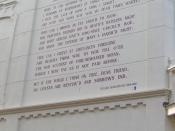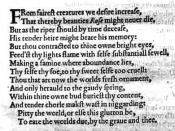The sonnet by William Shakespeare is a fourteen-line poem in iambic pentameter, comprising four sections: three quatrains, followed by a rhyming couplet. Each line has 10 syllables. It employs the traditional English sonnet rhyme-scheme: ABAB CDCD EFEF GG, thus we categorized it as a Shakespearean sonnet.
Quatrain one reflects the lonely feeling of the protagonist. Yellow leaves in line 2 refer to the leaves in autumn that are being blown away by the wind as winter approaches. The pauses in the line create the image of the remaining leaves being blown off the trees, perhaps to accentuate the feeling of loneliness. Usage of 'bare ruined choirs' reflect the feeling of being abandoned as the churches were at that time.
In the second quatrain, "twilight of such days' referring to the glory days of the protagonist which no longer exist as the 'sunset fadeth in the west'. The glory was rapidly taken away, as black night took away the twilight.
'Death's second self' in line 8 could be imagery for the coffin as it seals up (sealing of coffin) all in rest (rest in peace).
Quatrain 3 mentioned the 'glowing of such fire' which presumably refers to the love and passion of the protagonist which was depleted once his life ends. The protagonist was probably 'eaten up' emotionally by the very love that he once thrived on.
As in the rhyming couplet, it is all those mentioned previously that strengthened the love. "leave' in the last line could be a pun of live, meaning to love that well, one must live long.
The turn came at the rhyming couplet, when the sonnet talks about love. The previous 3 quatrains are illustrating scenes of sorrow, death and created a negative feeling. However, it was at the couplet that...


